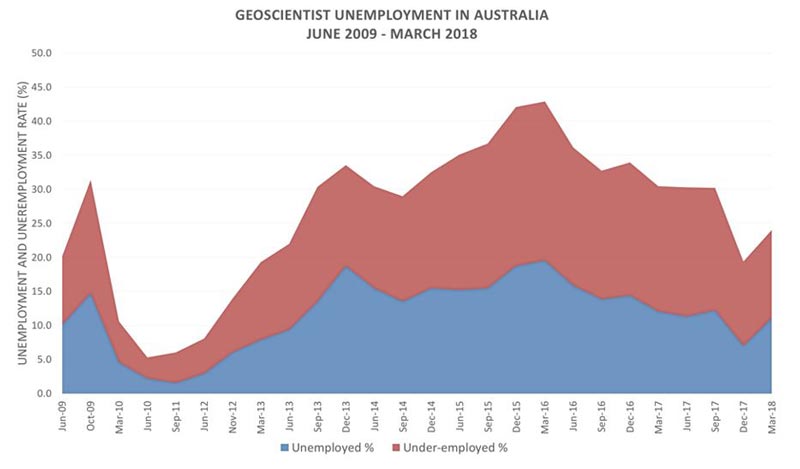Miners say they can’t find geos but geos say they can’t find jobs

Pic: John W Banagan / Stone via Getty Images
Geoscientists — scientists who study the earth and its natural resources — say the number of jobs are shrinking.
That’s an odd one given the recent increase in confidence in the resources sector.
Infact miners we spoke to this week tell a different story: they say good geologists are hard to find.
The Australian Institute of Geoscientists — which represents 3000 members — says unemployment among “geos” increased by more than 4 per cent to 11.1 per cent in the March quarter.
The figure was drawn from a survey of about 500 Australian geoscientists.
Institute spokesman Andrew Waltho described the result as a “setback” and evidence that a recovery in geoscientist employment, especially in exploration and mining, “has some way to go”.
“The final quarter of 2017 marked the fourth successive quarter of employment growth. So the decrease in employment prospects during the first quarter of 2018 is disappointing, particularly for those who have been seeking work for more than a year,” he said.
Every State witnessed an increase in unemployment during the March quarter.
In the States with significant numbers of geoscientists seeking work, Western Australia had the lowest unemployment, followed by South Australia and Queensland.
The highest level of unemployment was recorded in New South Wales and the ACT.

Miners say geo talent hard to find
Miners see it differently, however.
“We’ve just been through a period of recruitment and there’s not that much talent out there at the moment,” Great Boulder managing director Stefan Murphy told Stockhead on the sidelines of the Resources Rising Stars conference in Queensland’s Gold Coast.
“It’s actually pretty difficult to get good people.”
Great Boulder (ASX:GBR) is exploring for copper, nickel and cobalt at its Mt Venn project east of Laverton in Western Australia.
- Bookmark this link for small cap breaking news
- Discuss small cap news in our Facebook group
- Follow us on Facebook or Twitter
- Subscribe to our daily newsletter
Meanwhile Pilbara Minerals (ASX:PLS) boss Ken Brinsden told Stockhead the market had “tightened a bit”.
“More geos have been employed in WA than they probably have been in the last five or six years,” he said.
Pilbara Minerals, which is moving closer to production at its massive Pilgangoora lithium project in Western Australia’s Pilbara region, is in the process of expanding its team.
“We’re looking around for another guy at the moment and it’s not as easy as it was three years ago to find the right sort of candidate,” exploration manager John Holmes told Stockhead.
The opportunities for geos with years of experience to step up into more senior and management roles is increasing, according to Mr Holmes.
“There seems to be a lot of requirement for guys that have got five-to-10 years of experience,” he said.
“There’s certainly a shortage of those type of people.”
Mr Holmes says this is largely due to the growing number of junior IPOs and money flowing back into the resources sector.
12-month trend looks positive
The Institute, meanwhile, is hoping the increase in unemployment in the March quarter is a one-off.
“The trend over the past 12 months remains positive and we hope that this setback proves to be due to seasonal factors, affecting mineral exploration in particular, and isn’t a sign that exploration and mining activity in Australia is again showing signs of cooling in Australia,” Mr Waltho said.
While miners are not expecting to again experience skills shortages the likes of what was seen during the previous boom, they do see demand for these people picking up.
“I feel like that was a pretty intense level of activity that’s unlikely to be repeated,” Mr Brinsden said.
“Whilst things are tighter, we’d say they are far from being bad. It just means that there’s probably better opportunities for employees.
“The whole sector has come through a pretty nasty trough and we’re just starting to come out of the trough.”
UNLOCK INSIGHTS
Discover the untold stories of emerging ASX stocks.
Daily news and expert analysis, it's free to subscribe.
By proceeding, you confirm you understand that we handle personal information in accordance with our Privacy Policy.








